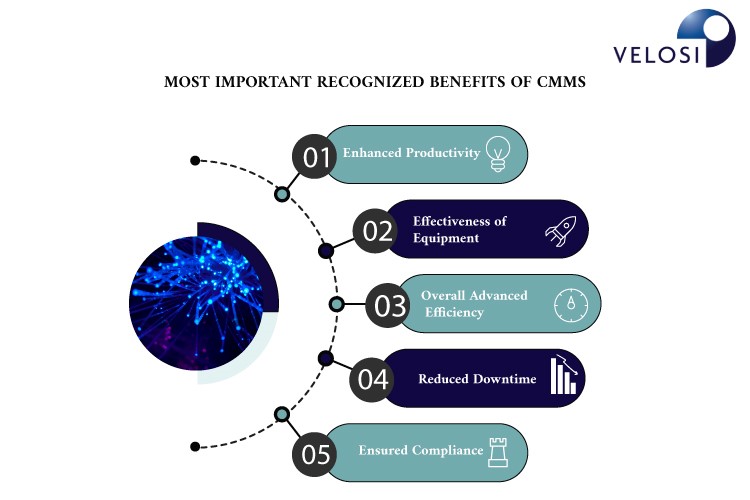Essential Steps to Successful CMMS Implementation
- August 1, 2022
- Posted by: Velosi Author
- Categories: CMMS, Insights, Software

Essential Steps to Successful CMMS Implementation
Nowadays innovation has marked its lead. As you move towards software success, you cannot take shortcuts or utilize procedures that are not recommended, which could be the most inefficient market practice. The implementation process of the CMMS software is equally substantial to its success as the software itself. It is imperative that you properly test the CMMS system thoroughly during the implementation phase to avoid any potential shortcomings.
A CMMS lets you create maintenance checklists, workflows, reporting templates, and more to make tasks easier and faster. These resources are also made digitally available, so everyone has access to the same information, follows the same best practices, and accomplishes the task quicker.
CMMS projects are successful if a few crucial steps are not missed during the implementation or execution phases. Every organization’s goal is to demonstrate the importance of excellent practices during the implementation of its CMMS system.
Let’s have a closer look into substantial fundamentals during the implementation of CMMS, there are some important factors that need to be considered.
Testing
We all are familiar with the crucial procedure of testing. Once the CMMS software is close to being launched officially, project management teams are eager to see it in action. This aspect of over-excitement can overshadow some important steps that should not be neglected. Also, downtime caused by improper implementation will add unnecessary frustrations once the system goes live. The CMMS testing phase sophisticatedly eliminates potential drawbacks like bugs and manages to protect your system to complete perfection to run smoothly after being live.
Overview & Inspect Resource Usability
In resource implementation, you should keep the following details in mind to ensure the project’s success.
- Overview and make sure that all working within the project team can properly utilize and understand test scripts.
- Inspect potential capabilities in the new system to bear the load you require for optimal productivity.
- Run tests and implement mock situations to foresee the system when it’s live.
Not to Oversee Management Change
Change in management is a step that almost all organizations don’t pay attention to. CMMS projects are particularly difficult to implement when management change occurs. It is unethical and unacceptable to run away from responsibilities and force employees to immediately work on a new software system. Appropriate training should be provided to fully adopt the system and enhance its productivity. To have efficient work output systematic training on the new software should be implemented within an organization.
Realistic Budgeting
To successfully carry out the implementation process, realistic budgeting is essential. You need to make sure that your budgets are set pessimistically, without if things will go well. In order to stay on the safe side, make sure that you have factored in unnecessary expenses from CMMS deployment.
A well-informed budget analysis executed by CMMS can assist the organization with significant decisions such as:
- Whether the finalized budget is accurate or not, getting familiar with the drawbacks to avoid common mistakes in the future.
- Analyzing and determining how the maintenance budget needs to be increased or decreased based on refined collected data.
- Identifying the adequacy of the budget for various maintenance areas and implementing spontaneous reallocation wherever necessary.
- Budget forecast accuracy relies on levels of data which include providing the ability to drill down into data at all levels including specified assets and all other associated repair costs.
Organize and Maintain Data Systematically
There is a lot of paperwork and clutter that accumulates over the year, so it is a good idea to clean the unnecessary pile. CMMS helps with the cleaning up process and creates less paperwork by using extensive tools such as the work order creation, preventative maintenance, and reports section. With an efficient CMMS system, you can make the process of de-cluttering very easy.
Data maintenance is the key to a successful CMMS solution. It enables you to put all your data within a single database being helpful and reducing downtime. In this fast pace moving environment, every organization is spontaneously competing with one another which clearly highlights that cleaning and organizing data pays off in the long run.
Data Scrubbing
Data scrubbing is also known as data cleaning. It specifically involves analyzing and identifying data errors further than changing, updating, or removing data to correct them. Taking a closer look, data scrubbing is the removal of unwanted or repeated present data before the relocation of the necessary data into CMMS. Certain errors arise gradually creating excessive downtime and frustration due to which clearance of unnecessary data is needed for organizations to eliminate the risk of numerous errors in their CMMS system.
Data scrubbing improves the overall quality of your data which plays a vital role in enhancing the productivity of your business.
Regulate Your Reporting Needs
Before implementing your new CMMS, discuss with different department heads the nature of reports they would like to see. The scheduling procedure and frequency of generating reports. When you think about reports in advance, you will ensure that the system is configured and used appropriately to access the desired information needed. Additionally, you can determine whether any customizations are necessary through this exercise. This exercise enables you to regularly automate the production of reports in your CMMS.
Audit Your CMMS In time
Your CMMS should be examined every six months, be sure to have the latest version of the software. Also, make sure you are getting the reports you need, and that you are taking full advantage of your CMMS’s capabilities. Users can also benefit from formal training at this time if they have questions or if there are new employees who need it. Maintaining your CMMS regularly ensures that your investment is protected, and maintenance savings are maximized.
Search For a Reliable Vendor
Last but not the least, Your CMMS system’s success depends on the vendor you choose. Ensure that your vendor is financially stable and has no proven liabilities against their name. It is essential to work with a vendor who is trustworthy and ready to meet all business requirements.
To conclude Velosi’s Computerized Maintenance Management System module addresses the complete life cycle of a technical object. With our maintenance management system VAIL, it is much easier to create and track technical life cycle management and implement strategic goals efficiently.
Figure 1 Important benefits of CMMS
Please contact us for more information and assistance.



